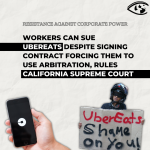US: Up Against Wal-Mart
Jennifer McLaughlin is 22, has a baby, drives a truck, wears wide-leg jeans and spiky plastic chokers, dyes her hair dark red, and works at Wal-Mart. The store in Paris, Texas.
Wal-Mart Supercenter #148 -- is just down the road from the modest apartment complex where McLaughlin lives with her boyfriend and her one-year-old son; five days a week she drives to the store, puts on a blue vest with; "How May I Help You?"; emblazoned across the back, and clocks in. Some days she works in the Garden Center and some days in the toy department. The pace is frenetic, even by the normally fast-paced standards of retailing; often, it seems, there simply aren't enough people around to get the job done. On a given shift McLaughlin might man a register, hop on a mechanical lift to retrieve something from a high shelf, catch fish from a tank, run over to another department to help locate an item, restock the shelves, dust off the bike racks, or field questions about potting soil and lawn mowers.
"It's stressful," she says."They push you to the limit. They just want to see how much they can get away with without having to hire someone else."
Then there's the matter of her pay. After three years with the company, McLaughlin earns only $16,800 a year"And I'm considered high-paid," she says. "The way they pay you, you cannot make it by yourself without having a second job or someone to help you, unless you've been there for 20 years or you're a manager." Because health insurance on the Wal-Mart plan would deduct up to $85 from her biweekly paycheck of $550, she goes without, and relies on Medicaid to cover her son, Gage.
Complaints about understaffing and low pay are not uncommon among retail workers -- but Wal-Mart is no mere peddler of saucepans and boom boxes. The company is the world's largest retailer, with $220 billion in sales, and the nation's largest private employer, with 3,372 stores and more than 1 million hourly workers. Its annual revenues account for 2 percent of America's entire domestic product. Even as the economy has slowed, the company has continued to metastasize, with plans to add 800,000 more jobs worldwide by 2007.
Given its staggering size and rapid expansion, Wal-Mart increasingly sets the standard for wages and benefits throughout the U.S. economy. "Americans can't live on a Wal-Mart paycheck,"says Greg Denier, communications director for the United Food and Commercial Workers International Union (UFCW). "Yet it's the dominant employer, and what they pay will be the future of working America."
The average hourly worker at Wal-Mart earns barely $18,000 a year at a company that pocketed $6.6 billion in profits last year. Forty percent of employees opt not to receive coverage under the company's medical plan, which costs up to $2,844 a year, plus a deductible. As Jennifer McLaughlin puts it, "They're on top of the Fortune 500, and I can't get health insurance for my kid.
Angered by the disparity between profits and wages, thousands of former and current employees like McLaughlin have started to fight the company on a variety of fronts. Workers in 27 states are suing Wal-Mart for violating wage-and-hour laws; in the first of the cases to go to trial, an Oregon jury found the company guilty in December of systematically forcing employees to work overtime without pay. The retailer also faces a sex-discrimination lawsuit that accuses it of wrongly denying promotions and equal pay to 700,000 women.
And across the country, workers have launched a massive drive to organize a union at Wal-Mart, demanding better wages and working conditions. Employees at more than 100 stores in 25 states -- including Supercenter #148 in Paris are currently trying to unionize the company, and in July the UFCW launched an organizing blitz in the Midwest, hoping to mobilize nearly 120,000 workers in Michigan, Kentucky, Ohio, and Indiana.
Wal-Mart has responded to the union drive by trying to stop workers from organizing -- sometimes in violation of federal labor law. In 10 separate cases, the National Labor Relations Board has ruled that Wal-Mart repeatedly broke the law by interrogating workers, confiscating union literature, and firing union supporters.
At the first sign of organizing in a store, Wal-Mart dispatches a team of union busters from its headquarters in Bentonville, Arkansas, sometimes setting up surveillance cameras to monitor workers. "In my 35 years in labor relations, I've never seen a company that will go to the lengths that Wal-Mart goes to, to avoid a union," says Martin Levitt, a management consultant who helped the company develop its anti-union tactics before writing a book called Confessions of a Union Buster. "They have zero tolerance."
Visit the Mother Jones site to read the full article.
- 189 Retail & Mega-Stores



